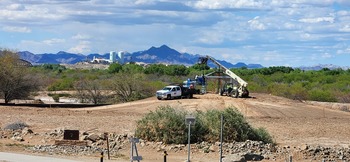News
Back to News
Construction of new East Wetlands overlook set to finish in coming months
The Yuma Crossing National Heritage Area (YCNHA) is about ready to unveil its newest and boldest creation at the Yuma East Wetlands. Sunset View Park, situated at the Wetlands’ southeast end, will boast a hilltop ramada, a 30-foot plaza with rock benches, and a network of trails.
Directly behind the Pacific Avenue Athletic Complex (PAAC) and across the canal, the park’s main plaza will be lined with native trees (mostly honey mesquite and palo verdes) and bushes, as well as a pollinator garden for a monarch butterfly habitat.
Newly constructed trails will access the ramada, whose design pays homage to the Yuma Territorial Prison’s iconic guard tower, from three sides, and they’ll connect the plaza to the parking lot and river access point to the north. An anti-flood irrigation system will also be installed and connected to the preexisting system of pumps along the river.
As far as the view:
“Not only will you see the marshes and the East Wetlands in its full capacity and beauty, but you’ll have the guard tower from the Yuma Territorial Prison and the bridge system. You’ll have the old [St. Thomas Yuma Indian] Mission on the Quechan land, and then the two water towers; iconic views of Yuma,” said Jesus Melendrez, YCNHA Wetlands and Facilities Manager.
Plans for this project began five years ago but faced a series of challenges along the way. Melendrez said the initial estimated cost of the project has increased 60 percent in the last five years, rendering the original budget not nearly large enough to account for this increase.
Other challenges included reassuring neighboring farmers that dust from the construction wouldn’t affect their crops, meeting the needs of the Bureau of Reclamation (BOR) and the Yuma Irrigation District (YID), and adhering to the City’s requirements by obtaining the requisite degrading and building permits.
“Several times we got to a point where we were like this is just not happening, let’s just quit, let’s just give the money back to the people that granted it to us and leave it alone,” Melendrez said. “It’s taken so long to get to this point, so many hurdles and challenges, but we stayed the course. [YCNHA Executive Director] Cathy Douglas and I put our fighting gloves on and kept fighting.”
The three largest grants utilized for the construction of this park came from the City of Yuma, the Southern Arizona Office of the U.S. National Park Service’s explorer program, which helped pay for the trails and the ramada, and AARP, which granted picnic tables, seating benches and trash cans, among other things.
The current funds sufficiently cover the cost of the ramada and trails, but more funding is needed to cover the plant material: trees, bushes, shrub, etc.
Melendrez said YCNHA is still looking for more money to finish the project, and they decided to start construction despite the lack of funds because he thinks if they hadn’t started, it never would have happened.
The Yuma Audubon Society has already started planting some of the materials needed for when the park is ready to have its raised plant beds filled, and trees will be sourced from local nurseries.
“Yuma Nursery is one of the big ones because they can actually bring in the bulk of what we need, but we always reach out to different sources throughout the state like the Gila Watershed Partnership and Green Heart Farms in California,” Melendrez said. He also said the local BOR donates extra and unused materials from nearby conservation projects.
All the heavy construction, trail plowing and anything that causes elevated noise will have to be completed by mid-April so as not to affect the migration or breeding of any of the species native to the East Wetlands.
“We’ll get all the big construction done, all the heavy lifting, everything that needs to get done, and we’ll find other sources of funding to buy the plants and continue to put it together as we go,” Melendrez said.
“There’s still some grading that has to be done by the heavy equipment guys, then my guys will take at least a week to build the trail system, and we’ll take about three or four days to install the irrigation. There’s going to be constant work. I would say by the end of May, you’ll have a product for people to come out and start enjoying it.”
Melendrez envisions the area being popular for the many birders who enjoy the East Wetlands’ bird viewing. He boasted that the East Wetlands is one of the most diverse bird habitats in the state.
The proximity to the PAAC and nearby hotels make the location great for visiting athletes to venture to the park to relax and meditate between games or tournaments. Melendrez mentioned he also sees yoga classes and weddings making use of the ramada/plaza area, which will be entirely wheelchair accessible.
“It’s all about trying to piggyback off what the city has over here, what we have, combining the two, and creating something special,” he said. “Whatever people can think of to do in this beautiful environment, that’s what we’re building it for, it’s for the community.”


